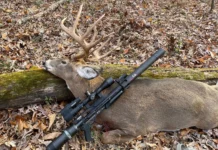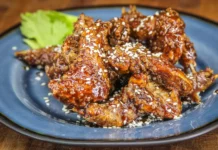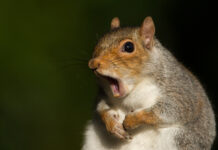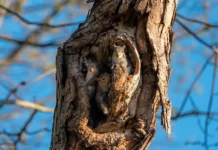The average force of a human bite is calculated at 162 pounds per square inch (PSI), but this is nothing compared to some animals with the strongest bite force.
The animal bite force is a complicated topic, and regardless of whether you choose to quantify it in PSI (pounds per square inch), pounds of force, or newtons of force, you are likely to come across a wide range of values that disagree with one another.
In addition, it is difficult to conduct biting force tests, which are rarely a high priority for scientists studying animals.
If such is the case, how can we determine which species have the most powerful bites in the world?
We can obtain a reliable estimate of what an animal’s peak biting force could be thanks to the testing that certain scientists have conducted and the advanced computer modeling that has been done.
Several factors, including the size of the animal’s meal, its jaw muscles, its jawbone, and the amount of surface area covered by its teeth, all contribute to the force with which an animal may bite.
According to a study conducted by Brown University, the amount of force within a muscle depends on the degree to which it is stretched.
As a result, the amount of force contained within an animal’s bite is also dependent on the size of what it is biting.
Psi, or pounds per square inch, is the unit of measurement for bite force. To be more precise, it is referred to as pounds of force per square inch (lbf/in2) because it represents the pressure that results from one pound of force on an area of one square inch (6.5 square centimeters).
In other words, the amount of force the animal applies to its meal.
Table of Contents
- 1 Does Bite Force Matter?
- 2 How Is Bite Force Calculated or Tested?
- 3 What Factors Determines Bite Force?
- 4 19 Animals with the Strongest Bite Force
- 4.1 1. Polar Bear (1,200 psi)
- 4.2 2. Gorilla (1,300 psi)
- 4.3 3. Jaguar (1,500 psi)
- 4.4 4. Hippopotamus (1,800 psi)
- 4.5 5. American Alligator (2,150 psi)
- 4.6 6. Great White Shark (4,000 psi)
- 4.7 7. Saltwater Crocodile (3,700 psi)
- 4.8 8. Lion (650 psi)
- 4.9 9. Nile Crocodile (3,000 – 5,000 psi)
- 4.10 10. Bull Shark (478 psi)
- 4.11 11. Black Piranha (72 psi)
- 4.12 12. Tasmanian Devil (200 psi)
- 4.13 13. Orcas (19,000 psi)
- 4.14 14. Tiger (1,050 psi)
- 4.15 15. Spotted Hyena (1,100 psi)
- 4.16 16. Grizzly Bear (1,000 to 1,200 psi)
- 4.17 17. Alligator Snapping Turtle (1,004 psi)
- 4.18 18. Humboldt Squid (6,00psi)
- 4.19 19. Walrus (1,850psi)
Does Bite Force Matter?
The animals with the strongest bite force are at an advantage in the wild. If you are a predator, having the ability to kill, incapacitate, or capture and hold prey by using huge levels of pressure when biting into it can be an advantage. Cracking up bones to access the marrow within them is also possible.
Herbivores are able to chew through tough foods such as bamboo, crunch through nuts and seeds, and help defend themselves against carnivores when they have stronger biting forces.
The strength of their jaws helps these creatures become effective hunters, which is why many of the animals with the strongest bite force are considered apex predators.
How Is Bite Force Calculated or Tested?
Utilizing a device such as a strain gauge or a bite meter is the most straightforward method for measuring the force of a bite.
The animal bites the device, which then measures the force. These scales are analogous to the electronic scales that individuals use to measure their weight.
You can’t just be pleasant to the animal and ask it to bite as hard as it can on some metal plate scale, nor is it easy to capture and handle many of the strongest creatures.
Nor can you ask the animal to bite as hard as it can. For example, doing this with sharks would be an extremely challenging endeavor.
When attempting to calculate the bite power of an animal, computer modeling and preliminary approximations can be of use.
Looking at what an animal is capable of doing is one of the things that can assist in determining how hard a bite will be.
It’s like how you power to scale your favorite superheroes by using their feats, but it’s much more accurate.
For instance, if you know that a certain animal can fracture the femur bone of an antelope, you can calculate the force required to achieve the same result.
This provides an accurate baseline minimum of the animal’s possible biting force, which one can use for comparison purposes.
Because of our comprehensive knowledge and extensive study of animal anatomy, we can employ computer modeling to assist in the calculation of biting force.
We can model and run simulations to determine a fairly accurate estimate of an animal’s bite force if we understand the correlation to skull size and shape and rough estimates of how much force jaw muscles are capable of exerting.
Furthermore, if we know how much force jaw muscles can exert.
What Factors Determines Bite Force?
There are several factors that go into determining animals with the strongest bite force.
Skull shape, bone density, plasticity, jaw muscle strength, nutrition, and tooth replacement are among the most important contributing factors.
The shape of the skull and jaw is essential when determining the amount of biting power.
The force applied is dispersed over a more controllable surface area when the jaw is smaller.
Sloped or inclined skulls provide superior leverage and better anchor points for the larger jaw muscles.
If you want to use a significant amount of force with any portion of your body, you must have robust enough bones to withstand the strain without breaking.
There are various creatures whose jaws can shatter or break bones, but when they do so, their own bones do not break.
There are a lot of different explanations for this, but the primary reason is that their jaw and skull bones are extremely dense, and their skulls have suitable angles for applying that force.
Both the skull and the jawbones have a significant capacity for plasticity. Scientists long believed that a T. rex could fracture its skull with a bite force that was likely as powerful as it had been.
Many animals, like the T. rex, have shock absorbers built into their skulls in the form of flexible joints.
These joints allow the skull and jaws to flex, preventing the force from rebounding on itself and causing injury.
The muscles in your jaw are responsible for your ability to open and close your mouth. While our jaw muscles did not evolve to be particularly robust, those of many other species did.
Having jaw and neck muscles that are both larger and stronger contributes to having a stronger bite power.
Along the path of evolution, every species has adapted and changed depending on available food sources.
Hunting is made safer and more effective by adaptations such as the ability to crush the skull of one’s victim like a jaguar does.
If they could only consume fruit or tender shoots, they would have a much more limited food selection than if they could chew through tough roots and shoots like gorillas.
These are some examples of animals that have naturally developed stronger jaws to accommodate the types of food that they eat.
The ability to replace teeth is essential for animals with the strongest bite force that gnaws through bone, although this is not always required.
There are species of sharks and crocodiles that, over the course of their lifetimes, lose hundreds or even thousands of teeth.
Suppose you want to be able to bite as forcefully as some of these animals do. In that case, you either need teeth that are extraordinarily durable or the ability to replace them in a short amount of time.
19 Animals with the Strongest Bite Force
1. Polar Bear (1,200 psi)
Polar bears are larger than their cousins, the grizzly bears, and reside in the Arctic region. Their diet consists mostly of large prey species.
These bears may weigh more than 1,200 pounds (544.31 kg), and their webbed paws allow them to excel as swimmers. They live in semi-aquatic environments.
Polar bears are among the animals with the strongest bite force, and they have a powerful bite that helps them to penetrate the thick skin, feathers, and fat of the prey they encounter in their natural habitat.
This allows them to hunt successfully. The majority of their diet consists of seals, whale carcasses, and whatever else they can get their teeth into.
2. Gorilla (1,300 psi)
The gorilla’s bite force is mostly determined by the thickness of its neck, even though gorillas are overly muscular.
Despite having extremely long and scary canine teeth, the largest ape species is a fairly quiet herbivore.
This is because they are critically endangered. Read this article to get an idea of the gorilla’s overall physical prowess.
Gorillas consume plants, although the majority of their food consists of tougher plant parts like roots, bamboo shoots, and other similar items.
They do not have to rely solely on young shoots and fruit because the force of their bite enables them to ground up and devour the many types of food.
3. Jaguar (1,500 psi)
Jaguars can deliver the most powerful bite of any of the great cats. They don’t bring their prey to the ground as other big cats do; instead, they strike by seizing their prey’s skull in their mouth and crushing it.
Their teeth and jaws are strong enough to break through the thick hide of caimans and the shells of turtles, and they can crush the heads of capybaras and other animals.
Jaguars thrive in the jungles of both North and South America. They normally grow to have a body length of five to six feet (1.52 m to 1.82 m), a tail length of three feet (0.91 m), and a body weight of approximately 250 pounds (113.39 kg).
4. Hippopotamus (1,800 psi)
Hippos are one of the animals with the strongest bite force that is still alive.
They use the enormous canines and incisors on their upper and lower jaws to defend their young from potential threats and to fight with one another.
Hippos are the most lethal mammal in Africa, accounting for more human deaths than any other species each year. Hippos kill more people than any other animal.
The aggressive behavior of hippos is not limited to people. Even though they drink from the same bodies of water, hippos despise crocodiles, and they are capable of breaking the backbone of a crocodile that is ten feet long (3.04 meters).
5. American Alligator (2,150 psi)
The bite force of an alligator is commensurate with its size as the largest living reptile in North America.
They have the ability to snap their jaws shut extremely quickly, which allows them to either crush or bite their prey in half.
The extremely powerful jaw muscles responsible for closing the mouth contribute to the incredible strength of their jaws.
You can use your hands to keep their mouths closed since the muscles that allow them to open their mouths are laughably underdeveloped compared to other muscles in their bodies.
Fish, wading birds, turtles, and smaller animals make up the majority of an alligator’s diet.
6. Great White Shark (4,000 psi)
The Great White Shark is a must-mention on the list of animals with the strongest bite force for no other reason than the fact that its bite force was estimated rather than measured.
In a study conducted in 2008, X-rays and computer modeling served as a means to assess the amount of biting force that a white shark would have.
The study showed that a white shark with a length of 21 feet (6.40 meters) could exert a bite force of approximately 4,000 pounds per square inch, making it one of the living animals with the strongest bite force.
You can find White sharks in many different parts of the world, including the Pacific Ocean, the northeastern United States, Australia, and South Africa.
They are the top apex predators, with only larger white sharks and killer whales being their natural enemies.
7. Saltwater Crocodile (3,700 psi)
As the largest members of the crocodile family, saltwater crocodiles make the list of animals with the strongest bite force and can weigh up to one thousand pounds.
They also hold the record for having the most powerful bite of any animal in the world.
Saltwater crocodiles are among the most dangerous animals on the planet; each year, they are responsible for the deaths of between 3,000 and 5,000 people.
This category requires a 17-foot croc with a 3,700 PSI bite measured by a top scientist.
By extrapolating these findings, the same researcher predicted that prehistoric crocodiles of 40 feet in length would have had a bite force of 23,000 pounds per square inch (PSI).
We should count ourselves fortunate that these monstrosities became extinct millions of years ago. We have enough problems with the more manageable version that is still there today.
The raw power these animals exhibit is so astounding that it is nerve-racking to contemplate how scientists must have compared powerful previous extinct animals to what these animals are capable of.
The biting force of a Tyrannosaurus rex is around 8,000 pounds per square inch (PSI), whereas the bite force of a megalodon is roughly 40,000 PSI using the same methods that determined the great white’s present strength.
Regardless of how powerful an individual animal can be, there are still lethal dangers that face the great majority of animals on this planet.
Strength is not the only quality that might be a contributing factor to risk.
8. Lion (650 psi)
Lions have a higher biting force than mastiff dogs, despite the ferocious reputation that they have earned and the iconic position that they have achieved.
As a result of the fact that they hunt in packs, pinning their prey to the ground and suffocating it, they have never required a biting force that is as powerful as that of tigers and jaguars.
9. Nile Crocodile (3,000 – 5,000 psi)
A well-known biologist researched the Nile crocodile as well as other species that are closely related to it.
Using sensitive instruments, he determined the average amount of force that each member of the Order Crocodilia exerts with their bite.
The fact that the Nile crocodile specimen measured was only about 8 feet in length is a limitation of the study.
Considering that the typical length of a Nile crocodile is 16 feet, it stands to reason that their actual bite strength should measure at or above 3,000 PSI. This value is higher than that of the American alligator regarding bite power.
The Nile crocodile, which can weigh up to a whopping 500 pounds and is native to the areas around the Nile River’s banks, is the crocodile species considered the most dangerous in the entire world.
They are solely accountable for more assaults on people than any other species of crocodile in the world. The primary reason for this is that they are so fiercely territorial and hostile.
10. Bull Shark (478 psi)
Bull sharks have the most powerful bite of any other shark species when considering the overall size.
They can grow to a maximum length of nine feet and an average weight of about 800 pounds, which is significantly less than white sharks.
The maximum pressure that a white shark of a similar size might generate is around 360 PSI.
11. Black Piranha (72 psi)
You’re probably looking at the meager biting force of a black piranha, which is only 72 PSI, and wondering why we included it here in the first place.
Black piranhas can reach a maximum length of around one meter and an average maximum weight of about eight pounds (3.62 kg).
Their biting force of 72 PSI is enormous compared to their body weight, and researchers took this measurement from a fish that only weighed about 2 and a half pounds (1.13 kg).
12. Tasmanian Devil (200 psi)
When considering animal size, Tasmanian devils have the most powerful biting force of any mammal and are among the animals with the strongest bite force.
They weigh only 19.07 kilograms (20 pounds), but when they bite, they can produce 553 newtons of force. Their bite’s Bite Force Quotient (BFQ) is greater than any other living mammal.
13. Orcas (19,000 psi)
A killer whale’s bite force has no measurement record, but estimates put it around 19,000 pounds per square inch (psi).
This is mostly because they are so enormous, as they may weigh up to six tons (6096.28 kg) and grow to a length of nineteen feet and fourteen inches (9.14 m).
Because the majority of the data is from simulations, theories, and experiments conducted on whales in captivity, this topic did not earn a place on the list.
14. Tiger (1,050 psi)
The average weight of a Bengal Tiger is between 250 and 500 pounds (113.39 kg and 226.79 kg).
Although India and China are where you may find these large cats in the greatest numbers, they are considered endangered because of their stunning fur and the usage of their bodies in traditional Chinese medicine.
Their relatives in Siberia are considerably larger and can weigh almost a thousand pounds (453.59 kg).
Tigers are solitary hunters for the most part, and their huge biting force enables them to quickly take down their chosen prey, which are large animals such as deer and wild boar.
As soon as they clamp their jaws around the neck of their prey, the animal is rendered helpless and eventually dies of asphyxiation. Only a few animals with the strongest bite force can easily perform this feat.
15. Spotted Hyena (1,100 psi)
Hyena packs are good hunters and voracious scavengers that have no problem feeding on the remains of prey that other predators killed.
They are also engaged in never-ending competition with lions because both species hunt the same species of prey, occupy the same areas, and frequently steal food from one another.
They can break through heavy animal bones to get to the marrow inside because of the arched shape of their skulls and the massive jaw muscles they possess.
One of the reasons that hyenas survive well, even when there is a shortage of prey, is that they can utilize bones as an additional food source.
16. Grizzly Bear (1,000 to 1,200 psi)
The grizzly Bear that lives in North America is a powerful animal in every way. A typical individual is approximately seven feet tall (2.13 meters) and weighs around 800 pounds (362.87 kg).
These omnivorous animals consume anything from fruits and nuts to fish and even animals as huge as moose. They don’t discriminate when it comes to what they eat.
According to urban legends, grizzly bears, one of the animals with the strongest bite force, can bite through bone, small trees, and even cast iron skillets with surprising ease.
17. Alligator Snapping Turtle (1,004 psi)
The alligator snapping turtle is not like other turtles in that it is not little, it is not cute, it is not slow, and it is not generally harmful.
Although they are shorter than the majority of the animals on our list of animals with the strongest bite force, averaging 26 inches in length, these little fellows are no laughing matter.
The bite force of an alligator snapping turtle is 1,004 pounds per square inch (PSI), which distinguishes it from the bite force of a typical snapping turtle.
Do you remember the enormous hippos that we discussed earlier? Even though this turtle is much smaller than the other mammal, its bite is still half as strong and considerably exceeds that of a human or, for that matter, your pet dog.
If you’re looking for a new shelled pet, it’s best to stick to the smaller species while you’re shopping around for one. This super-strong mouth could easily break off a finger or two.
18. Humboldt Squid (6,00psi)
A squid’s jaw isn’t the first thing that comes to mind when one imagines animals with the strongest bite force, so that’s understandable.
Squids are well-known for their peculiar structure, which consists of neither an internal nor an exterior skeleton.
Scientists estimate that this creature’s formidable beak possesses a biting force of over 6,000 pounds per square inch (PSI), although getting close to it is extremely risky and impossible.
This squid has eight tentacles, each with multiple suction cups to capture and immobilize its prey. As if it needed any extra assistance, this squid also has eight arms.
The powerful mouth muscles of these creatures then finish the job, leaving the other animals with no chance of survival.
19. Walrus (1,850psi)
How much damage could a giant floppy thing with an old man’s mustache actually do? A lot!
In spite of the fact that these goofy-looking critters appear to be soft and harmless, they consume a variety of different foods in addition to shellfish.
Walruses are one of animals with the strongest bite force and can kill seals and eat them very quickly. Their enormous tusks allow them to compete successfully against polar bears.
It is not simply the enormous size of a walrus’s tusks but also the strength of its mouth that makes it such a formidable opponent.
In a situation with a pressure of 1,850 PSI, seals do not have a chance of surviving.
If you ever think of a walrus as nothing more than a ball of fluff lounging around and collecting fish, keep in mind that it is perfectly capable of putting up a battle for its life if a polar bear comes knocking on its door.















































